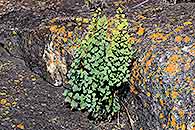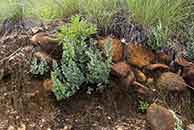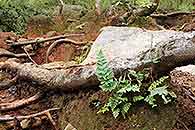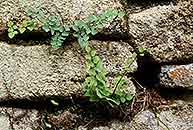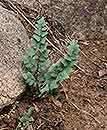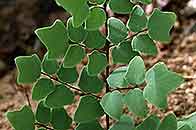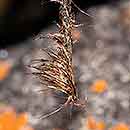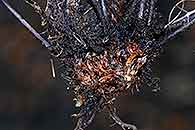Pellaea calomelanos (Sw.) Link var. calomelanos
Synonyms |
Pellaea hastata sensu Sim |
|---|---|
Common name |
Kabovora Mumvuriwedombo |
Description |
Rhizome erect to shortly creeping, c. 6 mm in diameter; rhizome scales linear-lanceolate in outline, apex slowly tapering to a point, margins pale, up to 10 mm long, black. Fronds monomorphic, tufted, erect to arching, 5-50 cm tall, coriaceous. Stipe 1-16(-30) cm long, round, black, very shining, hairless or finely set with orange-brown short hairs on the upper surface, sometimes with a few scales similar to the rhizome scales near the base, old stipe bases present. Lamina mostly 2-pinnate, occasionally 3-pinnate on the lower pinnae, ovate -lanceolate to narrowly triangular in outline, 10-43 × 2.5-25 cm; pinnae 7-12 pairs, opposite to slightly alternate, oblong-ovate in outline, 1.5-6 cm long; pinnules less than 2 cm long, rounded to broadly hastate, with 3-5 acute to rounded points, articulated, petiolate, grey to bluish green above, paler below, hairless; venetion free, hardly visible; rhachis and secondary rhachis shiny black, hairless or finely set with orange-brown short hairs on the upper surface. Sori borne in a continuous ridge along the margins, indusium continuous, entire, membranous. |
Notes | The rounded to broadly hastate pinnules, with typically 3-5 acute to rounded points, a grey-green colour and thick texture make this species easy to recognize. P. calomelanos var. swynnertoniana has larger fronds and pinnules that are more than 2 cm long; it is restricted to the east and southern parts of Zimbabwe. |
Derivation | kalos: pretty, melanos: dark; an allusion to the glossy black stipe and rhachis of the plant. |
Habitat | On rocky outcrops in woodland, dense bushland and grassland, favouring warm conditions in both dry and wet climates. |
Distribution worldwide | Africa, Madagascar, Comoro Isl., Mascarene Isl., nothern India, northeastern Spain. |
Distribution in Africa |
Angola, Botswana, Burundi, Dem. Republic of Congo, Ethiopia, Kenya, Lesotho, Malawi, Mozambique, Namibia, Rwanda, Somalia, South Africa, Sudan and South Sudan, Swaziland, Tanzania , Uganda, Zambia, Zimbabwe. |
Growth form |
Lithophytic, terrestrial. |
Literature |
|

